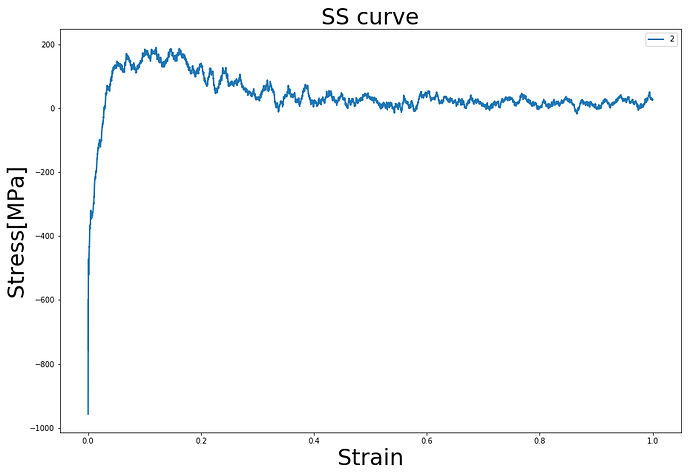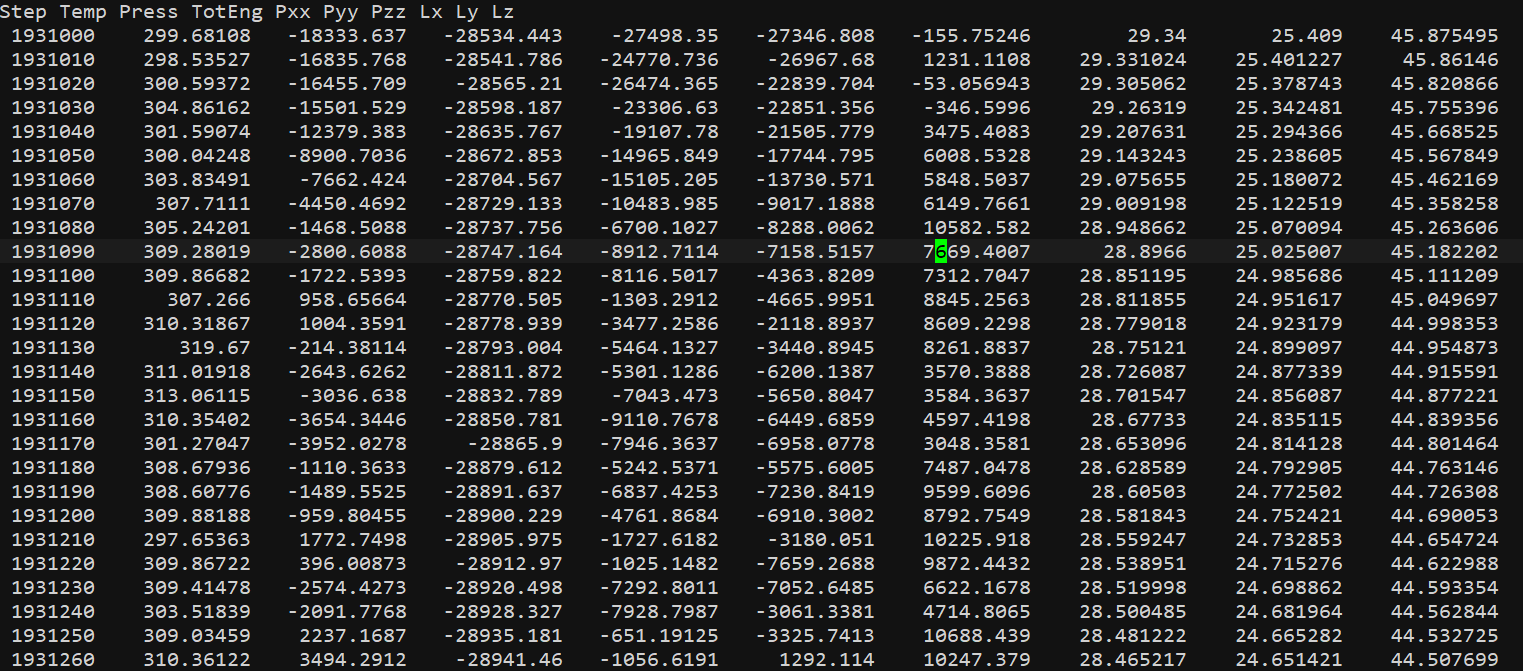Dear lammps users,
I am currently attempting to obtain the tensile strength (UTS) and Young’s modulus of my system by analyzing the stress-strain curve. However, I have noticed that the stress calculated at low strain is negative, which is unexpected since the stress should be zero at zero strain. Could you please advise me on what may be causing this issue and how I can obtain a proper stress-strain curve with zero stress and zero strain?
To provide some context, my system consists of both polymer (PCFF) and MOF (UFF), and I have equilibrated it in accordance with a reference paper. I then applied deformation in the z direction and measured the pressure using pzz. I have included my Lammps input below.
After analyzing my system, I have observed that the pzz value is consistently high after equilibration (around 1000 atm) even at NPT ensemble (fix 1 all npt temp 300 300 100 iso 1 1 1000). Could this be the cause of the issue? If so, what does a high pzz value indicate and how can I resolve this issue?
Thank you for your assistance.
include "system.in.init"
read_data "system.data"
include "system.in.settings"
neigh_modify every 1 delay 0 check yes
timestep 1.0
dump my_dump all atom 1000 dump.lammpstrj
minimize 1.0e-7 1.0e-9 1000 10000
velocity all create 600 1231
thermo_style custom step temp density press etotal lx ly lz
thermo 1000
fix 1 all nvt temp 600 600 100
run 5000
unfix 1
fix 1 all nvt temp 300 300 100
run 5000
unfix 1
fix 1 all npt temp 300 300 100 z 19.7 19.7 1000
run 5000
unfix 1
fix 1 all nvt temp 600 600 100
run 5000
unfix 1
fix 1 all nvt temp 300 300 100
run 10000
unfix 1
fix 1 all npt temp 300 300 100 z 592 592 1000
run 5000
unfix 1
fix 1 all nvt temp 600 600 100
run 5000
unfix 1
fix 1 all nvt temp 300 300 100
run 10000
unfix 1
fix 1 all npt temp 300 300 100 z 986 986 1000
run 5000
unfix 1
fix 1 all nvt temp 600 600 100
run 5000
unfix 1
fix 1 all nvt temp 300 300 100
run 10000
unfix 1
fix 1 all npt temp 300 300 100 z 493 493 1000
run 5000
unfix 1
fix 1 all nvt temp 600 600 100
run 5000
unfix 1
fix 1 all nvt temp 300 300 100
run 10000
unfix 1
fix 1 all npt temp 300 300 100 z 98 98 1000
run 5000
unfix 1
fix 1 all nvt temp 600 600 100
run 5000
unfix 1
fix 1 all nvt temp 300 300 100
run 10000
unfix 1
fix 1 all npt temp 300 300 100 z 9.8 9.8 1000
run 5000
unfix 1
fix 1 all nvt temp 600 600 100
run 5000
unfix 1
fix 1 all nvt temp 300 300 100
run 10000
unfix 1
fix 1 all npt temp 300 300 100 z 0.98 0.98 1000
run 800000
unfix 1
fix 1 all nvt temp 300 300 100
run 1000000
unfix 1
variable tmp equal "lz"
variable L0 equal ${tmp}
variable strain equal "(lz - v_L0)/v_L0"
variable p1 equal "v_strain"
variable p2 equal "-pxx/10000*1.01325"
variable p3 equal "-pyy/10000*1.01325"
variable p4 equal "-pzz/10000*1.01325"
variable p5 equal "lx"
variable p6 equal "ly"
variable p7 equal "lz"
fix 1 all npt temp 300 300 50 x 0 0 1000 y 0 0 1000 drag 2
fix 2 all deform 1 z erate 1e-6 units box remap x
fix def2 all print 100 "${p1} ${p4}" file def2.txt screen no
timestep 1
reset_timestep 0
run 1000000
write_data deform.data
unfix 1
unfix 2
---
system.data
LAMMPS Description
2440 atoms
2780 bonds
6312 angles
5820 dihedrals
2704 impropers
9 atom types
46 bond types
892 angle types
9 dihedral types
4 improper types
0 29.34 xlo xhi
0 25.409 ylo yhi
0.0 120 zlo zhi
-14.67 0 0 xy xz yz
---
system.in.init
atom_style full
units real
pair_style hybrid lj/cut/coul/long 10 lj/class2/coul/long 10
bond_style hybrid harmonic class2
angle_style hybrid fourier cosine/periodic class2
dihedral_style hybrid harmonic class2
improper_style hybrid fourier class2
special_bonds lj/coul 0.0 0.0 1.0
pair_modify tail yes mix arithmetic
kspace_style ewald 0.0001
boundary p p p

